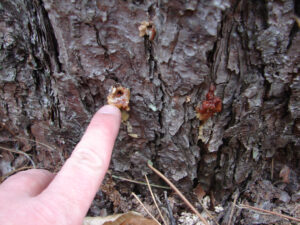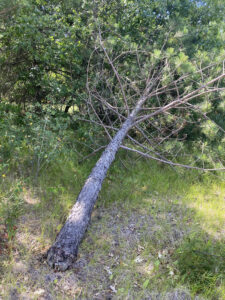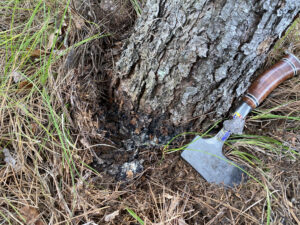
Pitch blobs near the base of a red pine indicate attack by red turpentine beetle. / Photo Credit: Linda Williams, Wisconsin DNR
By Linda Williams, Wisconsin DNR Forest Health Specialist
Linda.Williams@wisconsin.gov or 920-360-0665
Red turpentine beetle and pine root collar weevil are the most common insects found attacking near the base of red pine trees in Wisconsin, whether near ground level or just below ground level.
Here are some tips on identifying and controlling these pests.
Pine Root Collar Weevil

Damage at the base of a young red pine tree by pine root collar weevil can weaken it, causing stem breakage to occur. / Photo Credit: Linda Williams, Wisconsin DNR
Pine root collar weevil (Hylobius radices) prefers to attack younger red pine, generally pole-sized or smaller trees. They attack the root collar area, which should be at ground level unless the tree was previously planted too deeply. They will also infest the major roots that are just under the soil line.
Pulling the soil away from the base of the tree or away from the major roots of infested trees exposes soil soaked in black pitch. Removing the bark from the root collar area and from the major roots reveals damage from pine root collar larvae just under the bark. If weevil larvae have been feeding under the bark, the base of the tree may be slightly sunken.
The damage caused by the pine root collar weevil can girdle the tree and kill it, or it can create a weakened area of the tree, leading to tree breakage at ground level. If roots are damaged, they can break; trees may then tip over or lean heavily in one direction.
Pine root collar weevils prefer younger, open stands with grasses or weeds near the base of the trees to provide additional protection. They attack red pine, but they also infest Scotch, Austrian and jack pine and rarely white pine.
Management options depend on the age and stocking of the stand when the infestation is first noticed. If you have not yet planted, be sure to plant seedlings at the proper depth and avoid planting them too deeply. The root collar should be at the soil level.

A closer look at the base of a tree being attacked by pine root collar weevil, showing blackened, pitch-soaked dirt around the base of the tree. / Photo Credit: Linda Williams, Wisconsin DNR
Avoid planting near Scotch pine plantations, where infestations may be heavier. And plant at a density that will encourage rapid crown closure to limit problems with the weevils.
For established plantations, consider pruning the lower branches to facilitate more air flow to dry out the base of the trees. Also, pull back weeds and grasses from around the base of the trees to help dry them out and make the site less desirable to the weevils.
Some landowners have conducted a prescribed burn to remove the weeds and grasses from their plantations, but this is only an option if you are able to conduct a safe burn that follows a prescribed burn plan. Contact a forester for more information on prescribed burns.
Pesticides are not usually practical in forested situations but may be suitable for single trees or small numbers of trees.
Red Turpentine Beetle
The red turpentine beetle (Dendroctonus valens) is a large bark beetle that can attack red pine under stress. It generally prefers pole-sized and larger trees.
This beetle can also carry the spores of Leptographium root disease and, when introduced to a red pine, it can begin to spread through the roots and create expanding pockets of mortality, referred to as red pine pocket decline and mortality.
Red turpentine beetles often attack the lower 2 to 3 feet of the trunks of red pines that are under stress from other causes. This stress could be from an abiotic event such as drought, flooding or fire, or stress caused by stand thinning or trees being planted off-site.
Adult beetles bore into the bark to lay eggs under the bark. The tree will then start to exude pitch, which the beetles push out to create a blob of pitch, sometimes called a pitch tube. Pitch tubes will last for many months and are a noticeable clue that an attack is underway.
Larvae feed under the bark, and their damage can girdle areas, putting the rest of the tree under additional stress. If multiple pitch tubes are noticed at the base of a tree, the damage could be severe enough that Ips bark beetles (sometimes called pine engraver beetles) could attack the tree and kill it.
Maintaining tree health is the best way to limit infestation by the red turpentine beetle. When stress is severe and attacks are numerous, salvaging trees may be necessary.
What Else Could It Be?
Other tree issues could present somewhat similar symptoms:
Armillaria root disease can sometimes cause the base of infected red pine to weep moisture, or the lower bark can be water-soaked. Armillaria can also cause soil around the roots to seem water-soaked – but it won’t be as pitch-soaked, as seen with pine root collar weevil.
Also, Ips bark beetles can infest all areas of the tree, including the base of the tree and even some of the major roots.
